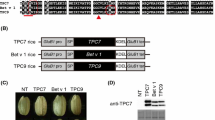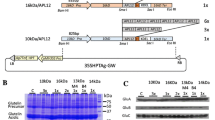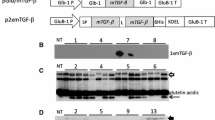Abstract
Rice-based peptide vaccine based on T cell epitopes acts as an ideal oral tolerogen for the treatment of type 1 allergic diseases. To improve production yields of oral tolerogen against Japanese cedar pollen allergy, hybrid peptide comprising seven predominant human T cell epitopes (7Crp) derived from Japanese cedar pollen allergens, Cry j 1 and Cry j 2, was produced in transgenic rice seed by expression of its codon optimized gene under the control of the endosperm-specific 26 kD globulin (Glb-1) promoter containing its signal peptide and the simultaneous suppression of endogenous seed storage proteins (SSPs) by RNA interference. Accumulation level of 7Crp peptide produced as a secretory protein was remarkably enhanced by suppression of both the 13–14 kDa prolamins and GluA and GluB glutelins as compared to those under suppression of either of them or in wild type rice. When these SSPs were down-regulated, the 7Crp peptide was observed to be localized in ER lumen as well as ER derived PBs (PB-Is). Especially, accumulation as self-aggregates in ER lumen increased by reduction of the endogenous 13–14 kDa prolamins. It is interesting to note that the absence of C terminal KDEL ER retention signal from the 7Crp peptide resulted in higher level accumulation (116 µg/grain) than that containing the KDEL.







Similar content being viewed by others
Abbreviations
- BiP:
-
Binding protein
- CDS:
-
Coding sequence
- CNX:
-
Calnexin
- Cys:
-
Cysteine
- ER:
-
Endoplasmic reticulum
- GALT:
-
Gut-associated lymphoid tissue
- Glb-1:
-
26 kDa Globulin
- PB:
-
Protein body
- PDIL:
-
Protein disulfide isomerase-like
- RNAi:
-
RNA interference
- 2-MER:
-
2-Mercaptoethanol
- SDS-PAGE:
-
Sodium dodecyl sulfate-polyacrylamide gel electrophoresis
- SSP:
-
Seed storage protein
References
Cabanos C, Kato N, Amari Y, Fujiwara K, Ohno T, Shimizu K, Goto T, Shimada M, Kuroda M, Masuda T, Takaiwa F, Utsumi S, Nagaoka S, Maruyama N (2014) Development of a novel transgenic rice with hypocholesterolemic activity via high-level accumulation of the α’ subunit of soybean β-conglycinin. Transgenic Res 23:609–620
Conrad U, Fiedler U (1998) Compartment-specific accumulation of recombinant immunoglobulins in plant cells: an essential tool for antibody production and immunomodulation of physiological functions and pathogen activity. Plant Mol Biol 38:101–109
Goossens A, Van Montagu M, Angenon G (1999) C0-introductionof an antisense gene for an endogenous seed storage protein can increase expression of a transgene in Arabidopsis thaliana seeds. FEBS Lett 456:160–164
Goto F, Yoshihara T, Sugimoto N, Toki S, Takaiwa F (1999) Iron fortification of rice seed by the soybean ferritin gene. Nat Biotechnol 17:282–286
Herman EM (2014) Soybean seed proteome rebalancing. Front Plant Sci 5:437
Hirahara K, Tatsuta T, Takatori T, Ohtsuki M, Kirinaka H, Kawaguchi J, Serizawa N, Taniguchi Y, Saito S, Sakaguchi M, Inouye S, Shiraishi A (2001) Preclinical evaluation of an immunotherapeutic peptide comprising 7 T-cell determinants of Cry j 1 and Cry j 2, the major Japanese cedar pollen allergens. J Allergy Clin Immunol 108:94–100
Hiroi T, Takaiwa F (2006) Peptide immunotherapy for allergic diseases using a rice-based edible vaccine. Curr Opin Allergy Clin Immunol 6:455–460
Iizuka M, Wakasa Y, Tsuboi H, Asashima H, Hirota T, Kondo Y, Matsumoto I, Takaiwa F, Sumida T (2014) Suppression of collagen-induced arthritis by oral administration of transgenic rice seeds expressing altered peptide ligands of type II collagen. Plant Biotechnol J 12:1143–1152
Kawakatsu T, Yamamoto MP, Hirose S, Yano M, Takaiwa F (2008) Characterization of a new rice glutelin gene GluD-1 expressed in the starchy endosperm. J Exp Bot 59:4233–4245
Kawakatsu T, Hirose Y, Yasuda H, Takaiwa F (2010) Reducing rice seed storage protein accumulation leads to changes in nutrient quality and storage organelle formation. Plant Physiol 154:1842–1854
Kim Y-M, Lee J-Y, Lee T, Lee Y-M, Kim S-H, Kang S-H, Yoon U-H, Ha S-H, Lim S-H (2012) The suppression of the glutelin storage protein gene in transgenic rice seeds results in a higher yield of recombinant protein. Plant Biotehnol Rep 6:347–353
Krishnan HB, Franceschi VR, Okita TW (1986) Immunochemical studies on the role of golgi complex in protein body formation in rice seeds. Planta 169:471–480
Kuroda M, Kimizu M, Mikami C (2010) A simple set of plasmids for the production of transgenic plants. Biosci Biotechnol Biochem 74:614–619
Kurokawa S, Kuroda M, Mejima M, Nakamura R, Takahashi Y, Sagara H, Takeyama N, Satoh S, Kiyono H, Teshima R, Masumura T, Yuki Y (2014) RNAi-mediated suppression of endogenous storage proteins leads to a change in localization of overexpressed cholera toxin B-subunit and the allergen protein RAG2 in rice seeds. Plant Cell Rep 33:75–87
Larche M (2007) Peptide immunotherapy for allergic diseases. Allergy 62:325–331
Marth K, Focke-Tejkl M, Lupinek C, Valenta R, Niederberger V (2014) Allergen peptides, recombinant allergens and hypoallergens for allergen-apecific immunotherapy. Curr Treat Options Allergy 26:91–106
Maruyama N, Fujiwara K, Yokoyama K, Cabanos C, Hasegawa H, Takagi K, Nishizawa K, Uki Y, Kawarabayashi T, Shouji M, Ishimoto M, Terakawa T (2014) Stable accumulation of seed storage proteins containing vaccine peptides in transgenic soybean seeds. J Biosci Bioeng 118:441–447
Mejima M, Kashima K, Kuroda M, Takeyama N, Kurokawa S, Fukuyama Y, Kiyono H, Itoh K, Mitsui T, Yuki Y (2015) Determination of genomic location and structure of the transgenes in marker-free rice-based cholera vaccine by using whole genome resequencing approach. Plant Cell Tiss Organ Cult 120:35–48
Ogo Y, wakasa Y, Hirano K, Urisu A, Matsuda T, Takaiwa F (2014) Generation of transgenic rice with reduced content of major and novel high molecular weight allergens. Rice 7:19
Okamoto Y, Horiguchi S, Yamamoto H, Yonekura S, Hanazawa T (2009) Present situation of cedar pollinosis in Japan and its immune responses. Allergol Int 58:155–162
Oono Y, Wakasa Y, Hirose S, Yang L, Sakuta C, Takaiwa F (2010) Analysis of ER stress in developing rice endosperm accumulating β-amyoid peptide. Plant Biotechnol J 8:691–718
Prickett SR, Rolland JM, O’Hehir RE (2015) Immunoregulatory T cell epitope peptides: the new frontier in allergy therapy. Clin Exp Allergy 45:1015–1026
Qu LQ, Takaiwa F (2004) Evaluation of tissue specificity and expression strength of rice seed component gene promoters in transgenic rice. Plant Biotechnol J 2:113–125
Saito Y, Shigemitsu T, Yamasaki R, Sasou A, Goto F, Kishida K, Kuroda M, Tanaka K, Morita S, Satoh S, Masumura T (2012) Formation mechanism of the internal structure of type I protein bodies in rice endosperm: relationship between the localization of prolamin species and the expression of individual genes. Plant J 70:1043–1055
Satoh R, Nakamura R, Komatsu A, Oshima M, Teshima R (2011) Proteomic analysis of known and candidate rice allergens between non-transgenic and transgenic plants. Regul Toxicol Pharmacol 59:437–444
Schmidt MA, Herman EM (2008) proteome rebalancing in soybean seeds can be exploited to enhance foreign protein accumulation. Plant Biotechnol J 6:832–842
Shigemitsu T, Ozaki S, Saito Y, Kuroda M, Morita S, Satoh S, Masumura T (2012) Production of human growth hormone in transgenic rice seeds: co-introduction of RNA interference cassette for suppressing the gene expression of endogenous storage proteins. Plant Cell Rep 31:539–549
Stoger E, Vaquero C, Torres E, Sack M, Nicholson L, Drossard J, Williams S, Keen D, Perrin Y, Christou P, Fischer R (2000) Cereal crops as viable production and storage systems for pharmaceutical scFv antibodies. Plant Mol Biol 42:583–590
Stoger E, Ma JK, Fischer R, Christou P (2005) Sowing the seeds of success: pharmaceutical proteins from plants. Curr Opin Biotechnol 16:167–173
Suzuki K, Kaminuma O, Yang L, Takai T, Mori A, Umezu-Goto M, Ohtomo T, Ohmachi Y, Noda Y, Hirose S, Okumura K, Ogawa H, Takada K, Hirasawa M, Hiroi T, Takaiwa F (2011) Prevention of allergic asthma by vaccination with transgenic rice seed expressing mite allergen: induction of allergen-specific oral tolerance without bystander suppression. Plant Biotechnol J 9:982–990
Tada Y, Utsumi S, Takaiwa F (2003) Foreign gene products can be enhanced by introduction into storage protein mutants. Plant Biotechnol J 1:411–422
Takagi H, Saito S, Yang L, Nagasaka S, Nishizawa N, Takaiwa F (2005a) Oral immunotherapy against a pollen allergy using a seed-based peptide vaccine. Plant Biotechnol J 3:521–533
Takagi H, Hiroi T, Yang L, Tada Y, Yuki Y, Takamura K, Ishimitsu R, Kawauchi H, Kiyono H, Takaiwa F (2005b) A rice-based edible vaccine expressing multiple T cell epitopes induces oral tolerance for inhibition of Th2-mediated IgE responses. Proc Natl Acad Sci USA 102:17525–17530
Takagi H, Hirose S, Yasuda H, Takaiwa F (2006) Biochemical safety evaluation of transgenic rice seeds expressing T cell epitopes of Japanese cedar pollen allergy. J Agric Food Chem 54:9901–9905
Takagi H, Hiroi T, Hirose S, Yang L, Takaiwa F (2010) Rice seed ER-derived protein body as an efficient delivery vehicle for oral tolerogenic peptides. Peptides 31:1421–1425
Takaiwa F (2013a) Increasing the production yield of recombinant protein in transgenic seeds by expanding the deposition space within the intracellular compartment. Bioengineered 4:136–139
Takaiwa F (2013b) Update on the use of transgenic rice seeds in oral immunotherapy. Immunotherapy 5:301–312
Takaiwa F, Takagi H, Hirose S, Wakasa Y (2007) Endosperm tissue is good production platform for artificial recombinant proteins in transgenic rice. Plant Biotechnol J 5:84–92
Takaiwa F, Yang L, Yasuda H (2008) Health-promoting transgenic rice seeds as a direct delivery system for bioactive peptides in human health. In: Hirano HY, Hirai A, Sano Y, Sasaki T (eds) Rice biology in the genomics era. Springer, Berlin, pp 357–373
Takaiwa F, Hirose S, Takagi H, Yang L, Wakasa Y (2009) Deposition of a recombinant peptide in ER-derived protein bodies by retention with cysteine-rich prolamins in transgenic rice seed. Planta 229:1147–1158
Takaiwa F, Wakasa Y, Takagi H, Hiroi T (2015) Rice seed for delivery of vaccines to gut mucosal immune tissues. Plant Biotechnol J 13:1041–1055
Takaiwa F, Yang L, Maruyama N, Wakasa Y, Ozawa K (2016) Deposition mode of transforming growth factor-β expressed in transgenic rice seed. Plant Cell Rep 35:2461–2473
Takaiwa F, Wakasa Y, Hayashi S, Kawakatsu T (2017) An overview on the strategies to exploit rice endosperm as production platform for biopharmaceuticals. Plant Sci 263:201–209
Takaiwa F, Yang L, Wakasa Y, Ozawa K (2018) Compensatory rebalancing of rice prolamins by production of recombinant prolamin/bioactive peptide fusion proteins within ER-derived protein bodies. Plant Cell Rep. https://doi.org/10.1007/s00299-017-2220-2
Tanaka K, Sugimoto T, Ogawa M, Kasai Z (1980) Isolation and characterization of two types of protein bodies in the rice endosperm. Agric Biol Chem 44:1633–1639
Urisu A, Yamada K, Masuda S, Komada H, Wada E, Kondo Y, Horiba F, Tsuruta M, Yasaki T, Yamada M, Torii S, Nakamura R (1991) 16-kilodalton rice protein is one of the major allergens in rice grain extract and responsible for cross-allergenicity between cereal grains in the Poaceae family. Int Arch Allergy Appl Immunol 96:244–252
Usui Y, Nakase M, Hotta H, Urisu A, Aoki N, Kitajima K, Matsuda T (2001) A 33-kDa allergen from rice (Oryza sativa L. Japonica) cDNA cloning, expression, and identification as a novel glyoxalase I. J Biol Chem 276:11376–11381
Valenta R, Ferreira F, Focke-Tejkl M, Linhart B, Niederberger V, Swoboda I, Vrtala S (2010) From allergen gene to allergy vaccines. Annu Rev Immunol 28:211–241
Van Droogenbroeck B, Cao J, Stadlmann J, Altmann F, Colanesi S, Hillmer S, Robinson DG, Van Lerberge E, Terryn N, Van Montagu M, Liang M, Depicker A, De Jaeger G (2007) Aberrant localization and underglycosylation of highly accumulating single-chain Fv-Fc antibodies in transgenic Arabidopsis seeds. Proc Natl Acad Sci USA 104:1430–1435
Wakasa Y, Takaiwa F (2013) The use of rice seeds to produce human pharmaceuticals for oral therapy. Biotechnol J 8:1133–1143
Wakasa Y, Yasuda H, Takaiwa F (2006) High accumulation of bioactive peptide in transgenic rice seeds by expression of introduced multiple genes. Plant Biotechnol J 4:499–510
Wakasa Y, Tamakoshi C, Ohno T, Hirose S, Goto T, Nagaoka S, Takaiwa F (2011a) The hypocholesterolemic activity of transgenic rice seed accumulating lactostatin, a bioactive peptide derived from bovine milk β-lactoglobulin. J Agric Food Chem 59:3845–3850
Wakasa Y, Yasuda H, Oono Y, Kawakatsu T, Hirose S, Takahashi H, Hayashi S, Yang L, Takaiwa F (2011b) Expression of ER quality control related genes in response to changes in BiP1 levels in developing rice endosperm. Plant J 65:675–689
Wakasa Y, Hayashi S, Takaiwa F (2012) Expression of OsBiP4 and OsBiP5 is highly correlated with the endoplasmic reticulum stress response in rice. Planta 236:1519–1527
Wakasa Y, Takagi H, Hirose S, Yang L, Saeki M, Nishimura T, Kaminuma O, Hiroi T, Takaiwa F (2013) Oral immunotherapy with transgenic rice seed containing destructed Japanese cedar pollen allergens, Cry j 1 and Cry j 2, against Japanese cedar pollinosis Plant Biotechnol J 11:66–76
Wu Y, Messing J (2014) Proteome balancing of the maize seed for higher nutritional value. Front Plant Sci 5:240
Yamada T, Saito H, Fujieda S (2014) Present state of Japanese cedar pollinosis: the national affliction. J Allergy Clin Immunol 133:632–639
Yang L, Hirose S, Takahashi H, Kawakatsu T, Takaiwa F (2012) Recombinant protein yield in rice seed is enhanced by specific suppression of endogenous seed proteins at the same deposit site. Plant Biotechnol J 10:1035–1045
Yasuda H, Hayashi Y, Jomori T, Takaiwa F (2006) The correlation between expression and localization of a foreign gene product in rice endosperm. Plant Cell Physiol 47:756–763
Yasuda H, Hirose S, Kawakatsu T, Wakasa Y, Takiwa F (2009) Overexpression of BiP has inhibitory effects on the accumulation of seed storage proteins in endosperm cells of rice. Plant Cell Physiol 50:1532–1543
Yuki Y, Mejima M, Kurokawa S, Hiroiwa T, Kong IG, Kuroda M, Takahashi Y, Nochi T, Tokuhara D, Kohda T, Kozaki S, Kiyono H (2012) RNAi suppression of rice endogenous storage proteins enhances the production of rice-based Botulinum neutrotoxin type A vaccine. RNAi suppression of rice endogenous storage proteins enhances the production of rice-based Botulinum neutrotoxin type A vaccine. Vaccine 30:4160–4166
Yuki Y, Mejima M, Kurokawa S, Hiroiwa T, Takahashi Y, Tokuhara D, Nochi T, Katakai Y, Kuroda M, Takeyama N, Kashima K, Abe M, Chen Y, Nakanishi U, Masumura T, Takeuchi Y, Kozuka-Hata H, Shibata H, Oyama M, Tanaka K, Kiyono H (2013) Induction of toxin-specific neutralizing immunity by molecularly uniform rice-based oral cholera toxin B subunit vaccine without plant-associated sugar modification. Plant Biotechnol J 11:799–808
Acknowledgements
We thank Ms. K. Miyashita, Y. Ikemoto and Y. Yajima for technical assistance, Dr. S. Saito (Jikei University of School of Medicine) for providing anti-7Crp monoclonal antibody, and Dr. Kenjiro Ozawa for encourage of this research. M.E was supported by Ministry of Science, Research and Technology of Iran.
Author information
Authors and Affiliations
Contributions
FT designed this research. ME, FT and YW conducted experiments. FT and ME wrote this manuscript. All authors read and approved the manuscript.
Corresponding author
Ethics declarations
Conflict of interest
The authors declare that they have no conflict of interest.
Additional information
Communicated by Sergio Rosales-Mendoza.
Electronic supplementary material
Below is the link to the electronic supplementary material.
11240_2018_1380_MOESM1_ESM.pdf
Supplementary material 1. Fig. S1—Effect on accumulation levels of KDEL less 7Crp peptide (7CrpKDEL(−)) by suppression of endogenous seed storage proteins. a SDS-PAGE analysis of total proteins extracted from non-transgenic Kita-ake and transgenic rice seeds containing various expression constructs. For detection of 7Crp peptide in mature transgenic rice seeds, immunoblot analysis was carried out using anti-7Crp antibody. For each construct, mature seeds from four independent representative expression lines were used for this analysis. Arrow indicates the expressed 7Crp peptide and size marker is shown on the left of gel. b Expression levels of endogenous seed proteins in mature transgenic rice seeds containing various expression constructs. Glutelins levels were examined by immunoblotting using antibodies specific to GluA, GluB and GluC. c Prolamin levels were examined by immunoblotting using antibodies specific to 16 kDa, RM1 (Cys-rich 14 kDa prolamin), RM2 (Cys-poor 13 kDa prolamin), RM4 (Cys-poor 13 kDa prolamin), RM9 (Cys-rich 14 kDa prolamin) and 10 kDa prolamins. Fig. S2—Effect of accumulation levels of 7Crp peptide for individual expression constructs by the presence or absence of KDEL signal. a WT/7Crp, b Proless/7Crp, c Gluless/7Crp, d Proless/ Gluless/7Crp. Blue circle, − KDEL; red circle, + KDEL; p positive control (transgenic rice containing 7Crp peptide 20 µg/grain). Fig. S3—Comparison of accumulation levels of 7Crp peptide between Proless/Gluless/7Crp and Proless/Gluless/7CrpKDEL(−). a SDS-PAGE of total seed proteins. b 7Crp and BiP4/5 levels were examined by Immunoblotting using anti-7Crp and antiBiP4/5 antibodies. (PDF 497 KB)
Rights and permissions
About this article
Cite this article
Entesari, M., Wakasa, Y., Zanjani, B.M. et al. Change in subcellular localization of overexpressed vaccine peptide in rice endosperm cell that is caused by suppression of endogenous seed storage proteins. Plant Cell Tiss Organ Cult 133, 275–287 (2018). https://doi.org/10.1007/s11240-018-1380-2
Received:
Accepted:
Published:
Issue Date:
DOI: https://doi.org/10.1007/s11240-018-1380-2




